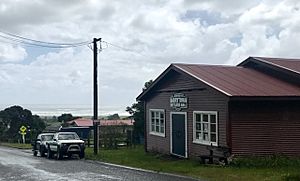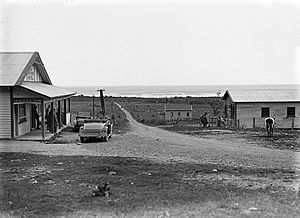Barrytown facts for kids
Quick facts for kids
Barrytown
|
|
|---|---|

Barrytown Hall
|
|
| Country | New Zealand |
| Region | West Coast |
| District | Grey District |
| Ward | Northern |
| Electorates |
|
| Area | |
| • Total | 30.27 km2 (11.69 sq mi) |
| Population
(2018 Census)
|
|
| • Total | 186 |
| • Density | 6.145/km2 (15.91/sq mi) |
| Local iwi | Ngāi Tahu |
Barrytown (originally known as Seventeen Mile Beach and Fosbery) is a town in the West Coast region of New Zealand's South Island. Barrytown sits on State Highway 6 and is 21 kilometres (13 mi) north of Runanga, on the Barrytown Flats. Punakaiki is 16 kilometres (10 mi) further north. The town is near the southern end of Pakiroa Beach. The Māori name for the region is Paparoa.
Contents
History
The land is originally Māori, and the local hapū is Ngāti Waewae of the iwi Ngāi Tahu. Pakiroa Beach along the Barrytown Flats was an important food source for local Māori, and middens of tuatua shells attributed to the iwi Waitaha have been dated to 1500 AD.
A gold rush in the 1860s led to workings at Seventeen Mile Beach and Canoe Creek, and by 1879 about 2000 miners were living in the area. In 1880 the township serving the miners was officially named "Fosebery" and a post office opened. The following year, however, a government opinion poll of residents and miners was held to choose between Fosbery and Barrytown. The 130 votes were unanimous for Barrytown.
By 1895, Barrytown had a Catholic church, a state school, two lodging-houses (Luis's and Cargill's), a smithy, and the All Nations Hotel. The two general stores, one including and butchery and bakery, were established in 1870 and 1879. The post office dispatched mail twice a week. By 1901 the population had dropped to 64, with an additional 60 people in the surrounding area.
Demographics
Barrytown is in an SA1 statistical area which covers 30.27 km2 (11.69 sq mi). The SA1 area is part of the larger Barrytown statistical area.
| Historical population for Barrytown and surrounds | ||
|---|---|---|
| Year | Pop. | ±% p.a. |
| 2006 | 132 | — |
| 2013 | 156 | +2.42% |
| 2018 | 186 | +3.58% |
The SA1 area had a population of 186 at the 2018 New Zealand census, an increase of 30 people (19.2%) since the 2013 census, and an increase of 54 people (40.9%) since the 2006 census. There were 69 households, comprising 93 males and 93 females, giving a sex ratio of 1.0 males per female. The median age was 47.6 years (compared with 37.4 years nationally), with 42 people (22.6%) aged under 15 years, 9 (4.8%) aged 15 to 29, 108 (58.1%) aged 30 to 64, and 27 (14.5%) aged 65 or older.
Ethnicities were 93.5% European/Pākehā, 9.7% Māori, 3.2% Pasifika, 1.6% Asian, and 1.6% other ethnicities. People may identify with more than one ethnicity.
Although some people chose not to answer the census's question about religious affiliation, 66.1% had no religion, 19.4% were Christian and 3.2% had other religions.
Of those at least 15 years old, 24 (16.7%) people had a bachelor's or higher degree, and 21 (14.6%) people had no formal qualifications. The median income was $21,100, compared with $31,800 nationally. 12 people (8.3%) earned over $70,000 compared to 17.2% nationally. The employment status of those at least 15 was that 66 (45.8%) people were employed full-time, 24 (16.7%) were part-time, and 6 (4.2%) were unemployed.
Barrytown statistical area
Barrytown statistical area, which also includes Blackball, covers 733.59 km2 (283.24 sq mi) and had an estimated population of 1,050 as of June 2023, with a population density of 1.4 people per km2.
| Historical population for Barrytown statistical area | ||
|---|---|---|
| Year | Pop. | ±% p.a. |
| 2006 | 918 | — |
| 2013 | 909 | −0.14% |
| 2018 | 939 | +0.65% |
Barrytown statistical area had a population of 939 at the 2018 New Zealand census, an increase of 30 people (3.3%) since the 2013 census, and an increase of 21 people (2.3%) since the 2006 census. There were 411 households, comprising 492 males and 450 females, giving a sex ratio of 1.09 males per female. The median age was 48.8 years (compared with 37.4 years nationally), with 150 people (16.0%) aged under 15 years, 120 (12.8%) aged 15 to 29, 525 (55.9%) aged 30 to 64, and 147 (15.7%) aged 65 or older.
Ethnicities were 93.6% European/Pākehā, 9.6% Māori, 1.9% Pasifika, 2.2% Asian, and 2.9% other ethnicities. People may identify with more than one ethnicity.
The percentage of people born overseas was 11.2, compared with 27.1% nationally.
Although some people chose not to answer the census's question about religious affiliation, 58.8% had no religion, 26.5% were Christian, 0.3% were Hindu, 0.6% were Muslim and 2.9% had other religions.
Of those at least 15 years old, 84 (10.6%) people had a bachelor's or higher degree, and 168 (21.3%) people had no formal qualifications. The median income was $26,500, compared with $31,800 nationally. 93 people (11.8%) earned over $70,000 compared to 17.2% nationally. The employment status of those at least 15 was that 384 (48.7%) people were employed full-time, 138 (17.5%) were part-time, and 39 (4.9%) were unemployed.
Economy and culture
Barrytown is a hub for arts and crafts, including stone carving and knife making.
All Nations Hotel
The Barrytown hotel was built in 1879, and taken over by Thomas Burns in 1884. It had seven bedrooms, and an additional building that slept 10. It was notable for its billiard room with an Alcock table. The hotel is still in operation today.
Barrytown Settlers Hall
Built in 1929, the Barrytown Settlers Hall is a well-known music venue and has been hosting gigs since 1972. International and local bands touring New Zealand often perform there include Blerta, Trinity Roots, the New Zealand Guitar Quartet, Karen Pfeiffer, Scott Cook and The Kugels, The Mint Chicks, Bad Manners and Don McGlashan. There have been as many as 25 events per year. In 2017, a crowdsourcing campaign (through 'Give a Little') was started to fund the soundproofing of the hall following resident complaints about noise.
Barrytown Flats
The town is located near the southern end of a 17 km (11 mi) coastal plain known as the Barrytown Flats. The sands were extensively sluiced and dredged for gold from the 1860s. The drier areas of the flats have been converted into pasture, but significant areas of forest remain, including Nikau Scenic Reserve. The flats are bordered by Paparoa National Park and the only breeding site of the Westland petrel (Procellaria westlandica). There are significant deposits of ilmenite (titanium dioxide) in the Barrytown sands, and there have been several mining proposals, but the possible environmental consequences have been contentious.
Education
The first school was built in the early 1880s after an inspector for the Westland Education Board visited Barrytown and determined there were 57 children of school age. The Central Board recommended that a school be built and a school committee established.
Barrytown School is a coeducational full primary (years 1–8) school with a roll of 37 students as of February 2024.
Climate
| Climate data for Barrytown (1981–2010) | |||||||||||||
|---|---|---|---|---|---|---|---|---|---|---|---|---|---|
| Month | Jan | Feb | Mar | Apr | May | Jun | Jul | Aug | Sep | Oct | Nov | Dec | Year |
| Mean daily maximum °C (°F) | 19.8 (67.6) |
20.4 (68.7) |
19.3 (66.7) |
17.1 (62.8) |
15.3 (59.5) |
13.4 (56.1) |
13.0 (55.4) |
13.4 (56.1) |
14.4 (57.9) |
15.4 (59.7) |
16.7 (62.1) |
18.6 (65.5) |
16.4 (61.5) |
| Daily mean °C (°F) | 16.4 (61.5) |
16.9 (62.4) |
15.8 (60.4) |
13.9 (57.0) |
12.2 (54.0) |
10.4 (50.7) |
9.8 (49.6) |
10.3 (50.5) |
11.3 (52.3) |
12.2 (54.0) |
13.4 (56.1) |
15.2 (59.4) |
13.2 (55.7) |
| Mean daily minimum °C (°F) | 12.9 (55.2) |
13.3 (55.9) |
12.3 (54.1) |
10.6 (51.1) |
9.2 (48.6) |
7.4 (45.3) |
6.6 (43.9) |
7.2 (45.0) |
8.2 (46.8) |
9.0 (48.2) |
10.1 (50.2) |
11.9 (53.4) |
9.9 (49.8) |
| Average rainfall mm (inches) | 246.3 (9.70) |
181.9 (7.16) |
200.4 (7.89) |
220.4 (8.68) |
255.5 (10.06) |
225.0 (8.86) |
223.5 (8.80) |
168.2 (6.62) |
228.3 (8.99) |
248.2 (9.77) |
243.7 (9.59) |
290.6 (11.44) |
2,732 (107.56) |
| Source: NIWA (rain 1971–2000) | |||||||||||||



